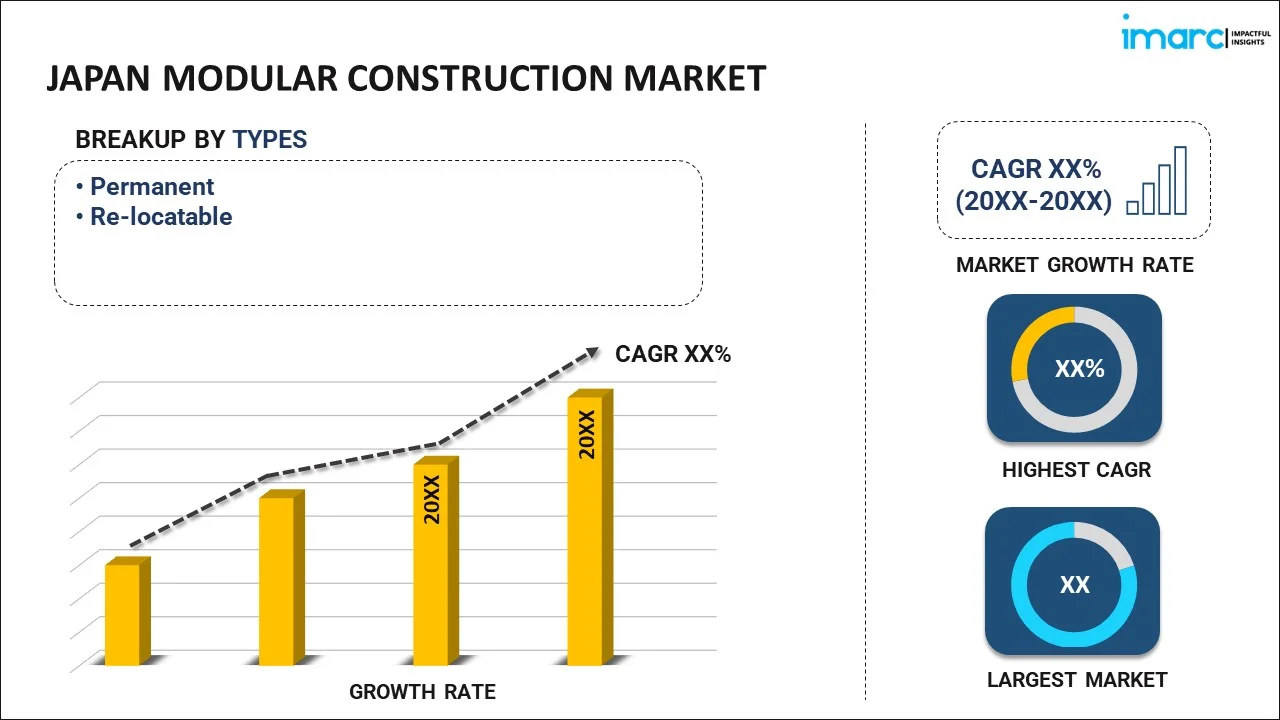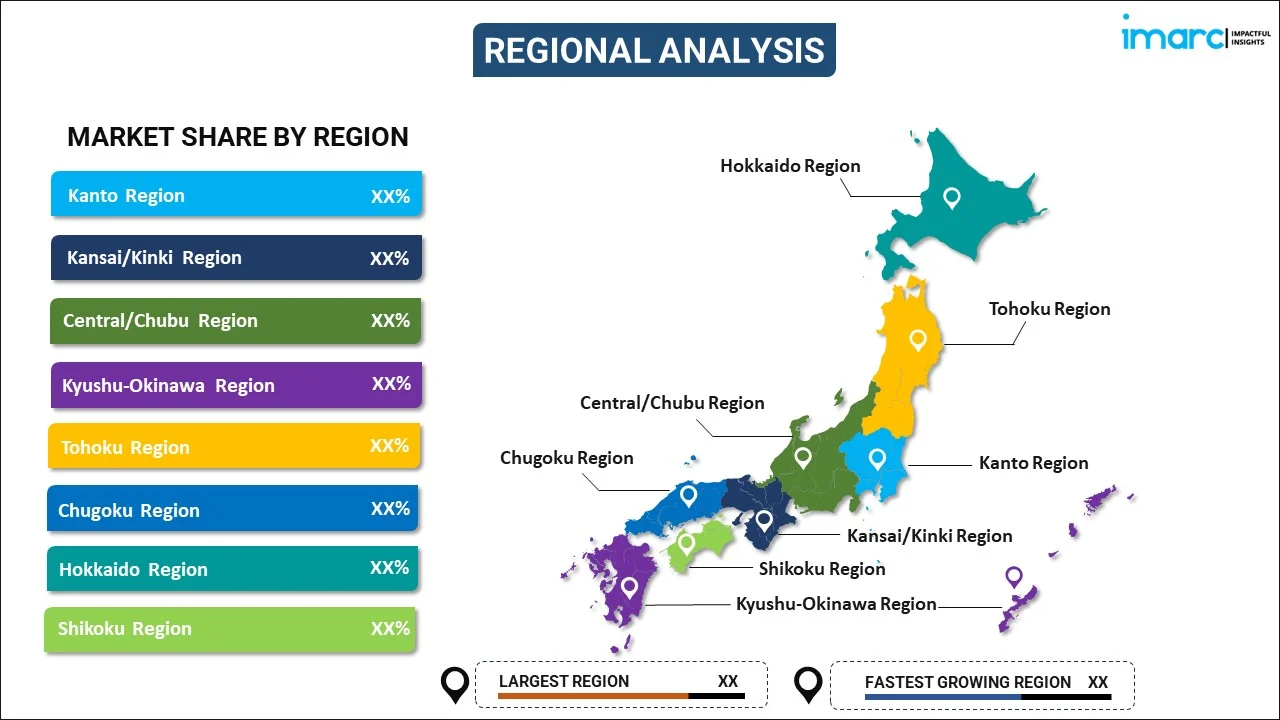
Japan Modular Construction Market Report by Type (Permanent, Re-locatable), Material (Steel, Wood, Concrete, and Others), End User (Residential, Commercial, Industrial), and Region 2025-2033
Market Overview:
Japan modular construction market size reached USD 17.10 Billion in 2024. Looking forward, IMARC Group expects the market to reach USD 27.70 Billion by 2033, exhibiting a growth rate (CAGR) of 5.89% during 2025-2033. The increasing rise in urbanization that has led to a high demand for construction in urban areas, coupled with the escalating demand for quick and efficient modular construction techniques, is primarily driving the market.
|
Report Attribute
|
Key Statistics
|
|---|---|
|
Base Year
|
2024 |
|
Forecast Years
|
2025-2033 |
|
Historical Years
|
2019-2024
|
| Market Size in 2024 | USD 17.10 Billion |
| Market Forecast in 2033 | USD 27.70 Billion |
| Market Growth Rate (2025-2033) | 5.89% |
Modular construction is a construction method that involves building structures using pre-fabricated, pre-designed modules or components. These modules are manufactured in a controlled factory environment and then transported to the construction site for assembly. Each module typically includes elements such as walls, floors, ceilings, and sometimes even plumbing and electrical systems. Modular construction offers several advantages, including reduced construction time and costs. The controlled factory conditions ensure high-quality manufacturing and reduce weather-related delays. Additionally, the ability to mass-produce modules can lead to cost savings. This approach is also more environmentally friendly, as it generates less construction waste and often allows for efficient energy usage in the finished building. Modular construction is versatile and can be used for various building types, including residential homes, commercial buildings, and even healthcare facilities. Its flexibility and efficiency make it an increasingly popular choice in the construction industry, meeting the demands of modern construction projects while minimizing disruptions to the surrounding environment.
Japan Modular Construction Market Trends:
The modular construction market in Japan, driven by several key factors, is rapidly gaining momentum in today's construction industry. Firstly, the growing regional population and urbanization trends are putting immense pressure on the construction sector to provide efficient and sustainable solutions. Consequently, the need for quicker and cost-effective construction methods is pushing modular construction into the spotlight. Moreover, advancements in technology, particularly in the field of Building Information Modeling (BIM) and 3D printing, have greatly improved the precision and customization potential of modular construction. This, in turn, enhances design flexibility and minimizes errors, serving as another compelling driver for its adoption. Furthermore, the heightened focus on sustainability and reduced carbon footprint is steering the industry towards modular construction. The ability to manufacture components in controlled environments reduces material wastage and energy consumption, aligning with the broader environmental goals of many regions. Additionally, the ongoing labor shortage in the construction industry, which is prompting companies to turn to modular construction as a solution to labor-related challenges, is expected to drive the market in Japan during the forecast period.
Japan Modular Construction Market Segmentation:
IMARC Group provides an analysis of the key trends in each segment of the market, along with forecasts at the country level for 2025-2033. Our report has categorized the market based on type, material, and end user.
Type Insights:

- Permanent
- Re-locatable
The report has provided a detailed breakup and analysis of the market based on the type. This includes permanent and re-locatable.
Material Insights:
- Steel
- Wood
- Concrete
- Others
A detailed breakup and analysis of the market based on the material have also been provided in the report. This includes steel, wood, concrete, and others.
End User Insights:
- Residential
- Commercial
- Industrial
The report has provided a detailed breakup and analysis of the market based on the end user. This includes residential, commercial, and industrial.
Regional Insights:

- Kanto Region
- Kansai/Kinki Region
- Central/ Chubu Region
- Kyushu-Okinawa Region
- Tohoku Region
- Chugoku Region
- Hokkaido Region
- Shikoku Region
The report has also provided a comprehensive analysis of all the major regional markets, which include Kanto Region, Kansai/Kinki Region, Central/ Chubu Region, Kyushu-Okinawa Region, Tohoku Region, Chugoku Region, Hokkaido Region, and Shikoku Region.
Competitive Landscape:
The market research report has also provided a comprehensive analysis of the competitive landscape. Competitive analysis such as market structure, key player positioning, top winning strategies, competitive dashboard, and company evaluation quadrant has been covered in the report. Also, detailed profiles of all major companies have been provided.
Japan Modular Construction Market Report Coverage:
| Report Features | Details |
|---|---|
| Base Year of the Analysis | 2024 |
| Historical Period | 2019-2024 |
| Forecast Period | 2025-2033 |
| Units | Billion USD |
|
Scope of the Report |
Exploration of Historical and Forecast Trends, Industry Catalysts and Challenges, Segment-Wise Historical and Predictive Market Assessment:
|
| Types Covered | Permanent, Re-locatable |
| Materials Covered | Steel, Wood, Concrete, Others |
| End Users Covered | Residential, Commercial, Industrial |
| Regions Covered | Kanto Region, Kansai/Kinki Region, Central/ Chubu Region, Kyushu-Okinawa Region, Tohoku Region, Chugoku Region, Hokkaido Region, Shikoku Region |
| Customization Scope | 10% Free Customization |
| Post-Sale Analyst Support | 10-12 Weeks |
| Delivery Format | PDF and Excel through Email (We can also provide the editable version of the report in PPT/Word format on special request) |
Key Questions Answered in This Report:
- How has the Japan modular construction market performed so far and how will it perform in the coming years?
- What has been the impact of COVID-19 on the Japan modular construction market?
- What is the breakup of the Japan modular construction market on the basis of type?
- What is the breakup of the Japan modular construction market on the basis of material?
- What is the breakup of the Japan modular construction market on the basis of end user?
- What are the various stages in the value chain of the Japan modular construction market?
- What are the key driving factors and challenges in the Japan modular construction?
- What is the structure of the Japan modular construction market and who are the key players?
- What is the degree of competition in the Japan modular construction market?
Key Benefits for Stakeholders:
- IMARC’s industry report offers a comprehensive quantitative analysis of various market segments, historical and current market trends, market forecasts, and dynamics of the Japan modular construction market from 2019-2033.
- The research report provides the latest information on the market drivers, challenges, and opportunities in the Japan modular construction market.
- Porter's five forces analysis assist stakeholders in assessing the impact of new entrants, competitive rivalry, supplier power, buyer power, and the threat of substitution. It helps stakeholders to analyze the level of competition within the Japan modular construction industry and its attractiveness.
- Competitive landscape allows stakeholders to understand their competitive environment and provides an insight into the current positions of key players in the market.
Need more help?
- Speak to our experienced analysts for insights on the current market scenarios.
- Include additional segments and countries to customize the report as per your requirement.
- Gain an unparalleled competitive advantage in your domain by understanding how to utilize the report and positively impacting your operations and revenue.
- For further assistance, please connect with our analysts.
 Inquire Before Buying
Inquire Before Buying
 Speak to an Analyst
Speak to an Analyst
 Request Brochure
Request Brochure
 Request Customization
Request Customization




.webp)




.webp)












